阿祖总结-Zu.Stone@QQ.com
LoadRunner 函数大全之中文解释
// button_press 函数激活指定的推按钮。
int button_press ( LPCSTR button );
// button_set 函数将按钮状态设置为 ON 或 OFF。
int button_set ( LPCSTR button, int state );
// close_session 函数关闭所有打开的窗口并结束
// 当前的 Baan 会话。在 Baan 模板中创建的此函数
// 出现在脚本的 vuser_end 部分中。
int close_session();
// edit_get_text 函数返回在指定 edit 对象中
// 找到的所有文本。若要从特定块中读取文本,
// 请使用 edit_get_block。
int edit_get_text ( LPCSTR edit, char *out_string );
// edit_set 函数使用指定的字符串设置 edit 对象的
// 内容。该字符串将替换任何现有字符串。
int edit_set ( LPCSTR edit, LPCSTR text );
// edit_set_insert_pos 函数将光标放置
// 在 edit 对象内的指定位置。
int edit_set_insert_pos (LPCSTR edit, int row, int column );
// edit_set_selection 函数突出显示指定文本。
int edit_set_selection ( LPCSTR edit, int start_row, int start_column, int end_row, int
end_column );
// edit_type 函数将文本字符串输入到 edit
// 对象中。该文本字符串不会替换现有字符串;
// 它替换的是位于当前光标位置的指定文本。
int edit_type ( LPCSTR edit, LPCSTR text );
// init_session 函数通过指定登录数据和配置
// 信息打开 Baan 连接。此函数向 Baan 服务器
// 呈现包含在 Baan Configuration 部分中
// 的信息。
int init_session ( char * host, char * user, char *password, char *BSE, char *Bshell_name, char
* settings );
// list_activate_item 函数双击列表中的项目。
1
�
阿祖总结-Zu.Stone@QQ.com
// 项目可由其逻辑名称指定。
int list_activate_item ( LPCSTR list, LPCSTR item );
// list_collapse_item 函数隐藏展开的 TreeView
// 列表中的子项,例如文件夹中的各个文件。
int list_collapse_item (LPCSTR list, LPCSTR item );
// list_expand_item 函数显示展开的
// TreeView 列表中所隐藏的子项,例如
// 文件夹中的各个文件。
int list_expand_item (LPCSTR list, LPCSTR item );
// list_get_selected 函数返回列表中的选定
// 项目。它既查找标准列表,也查找多选项列表。
int list_get_selected (LPCSTR list, LPCSTR out_item, LPCSTR out_num );
// list_select_item 函数从列表中选择项目
// (在项目上执行一次鼠标单击)。项目可由
// 其名称或数字索引指定。索引被指定为一个
// 字符串,并前置有字符 #。列表中的第一个
// 项目编号为 0。例如,列表中的第三个项目
// 将表示为 "#2"。
int list_select_item ( LPCSTR list, LPCSTR item );
// menu_select_item 函数根据菜单
// 的逻辑名称和项目名称从菜单中选择
// 项目。注意,菜单和项目表示为单个
// 字符串,并使用分号分隔。
int menu_select_item ( LPCSTR menu_item );
// obj_get_info 函数检索指定属性的值,
// 并将其存储在 out_value 中。
int obj_get_info ( LPCSTR object, LPCSTR property, char *out_value );
// obj_get_text 函数从指定的对象
// 或对象区域中读取文本。
int obj_get_text (LPCSTR object, LPCSTR out_text );
// obj_mouse_click 函数在对象内的
// 指定坐标处单击鼠标。
int obj_mouse_click ( LPCSTR object, int x, int y, [mouse_button] );
// obj_mouse_dbl_click 函数在对象内的
// 指定坐标处双击鼠标。
2
�
阿祖总结-Zu.Stone@QQ.com
int obj_mouse_dbl_click ( LPCSTR object, int x, int y, [mouse_button] );
// obj_mouse_drag 函数在 GUI
// 对象中执行鼠标拖动操作。指定的
// 坐标是相对于 GUI 对象(而非
// 屏幕)的左上角。
int obj_mouse_drag (LPCSTR object, int start_x, int start_y, int end_x, int end_y, [ ButtonT
mouse_button] );
// obj_type 函数指定将 keyboard_input
// 发送到的目标对象。
int obj_type ( LPCSTR object, unsigned char keyboard_input, [unsigned char modifier ] );
// obj_wait_info 函数等待对象
// 属性达到指定值,然后继续
// 测试运行。如果未达到指定
// 值,则函数将一直等到时间
// 到期,然后再继续测试。
int obj_wait_info (LPCSTR object, LPCSTR property, LPCSTR value, UINT time );
// scroll_drag_from_min 函数将滚动屏
// 移动到与最小位置相距指定距离的位置。
int scroll_drag_from_min ( LPCSTR object, [int orientation], int position );
// scroll_line 函数滚动指定行数。
// 此函数可用于滚动栏和滑块对象。
int scroll_line ( LPCSTR scroll, [ScrollT orientation], int lines );
// scroll_page 函数将滚动屏移动指定页数。
int scroll_page ( LPCSTR scroll, [ScrollT orientation], int pages );
// set_default_timeout 函数设置回放
// 期间 Baan Vuser 函数的超时期间段。
// 例如,当脚本执行 set_window 函数
// 时,如果窗口在指定超时时间段内没有
// 出现,则会生成错误。
void set_default_timeout ( long time );
// set_exception 函数指定在发生异常时
// 应执行的操作。应指定要调用以处理异常
// 窗口的函数。
void set_exception ( LPCSTR title, long function );
// set_think_time 函数指定脚本执行
3
�
阿祖总结-Zu.Stone@QQ.com
// 期间要使用的思考时间范围。运行脚本
// 时,LoadRunner 使用指定范围内的
// 随机思考时间,并在每个操作完成后
// 暂停该思考时间长度。
void set_think_time ( USHORT start_range, USHORT end_range );
// set_window 函数将输入定向到
// 当前应用程序窗口并在 GUI 图中
// 设置对象标识范围。
int set_window ( LPCSTR window [, int timeout ] );
// start_session 函数在 Baan
// 服务器上开始指定的会话。
int start_session ( LPCSTR session );
// static_get_text 函数返回在指定
// 静态 text 对象中找到的所有文本。
int static_get_text ( LPCSTR static_obj, LPCSTR out_string );
// tab_select_item 函数选择一个选项卡项目。
int tab_select_item ( LPCSTR tab, LPCSTR item );
// tbl_activate_cell 函数在指定表单元格中
// 按 Enter 键。如果指定了列名,LoadRunner
// 将直接从数据库中获取该名称。
int tbl_activate_cell (LPCSTR table, LPCSTR row, LPCSTR column );
// tbl_get_cell_data 函数根据
// 单元格包含的数据类型获取表中
// 指定单元格的内容。如果指定了
// 列名,将从数据库自身(而非应用
// 程序)中获取该名称。
int tbl_get_cell_data (LPCSTR table, LPCSTR row, LPCSTR column, LPCSTR out_text );
// tbl_get_selected_cell 函数
// 检索焦点所在的表单元格的行号和
// 列名。注意,列名取自数据库自身,
// 而非应用程序。
int tbl_get_selected_cell (LPCSTR table, char *out_row, char *out_column );
// tbl_press_zoom_button 函数
// 激活指定表单元格的缩放窗口。
int tbl_press_zoom_button ( LPCSTR table, LPCSTR row, LPCSTR column );
4
�
阿祖总结-Zu.Stone@QQ.com
// tbl_set_cell_data 函数根据单元格
// 包含的数据类型使用指定数据设置单元格
// 的值。如果指定了列名,LoadRunner
// 将直接从数据库中获取该名称。
int tbl_set_cell_data (LPCSTR table, LPCSTR row, LPCSTR column, LPCSTR data );
// tbl_set_selected_cell 函数将焦点
// 设置到表中的指定单元格上。指定列名时,
// LoadRunner 将直接从数据库中获取该名称。
int tbl_set_selected_cell (LPCSTR table, LPCSTR row, LPCSTR column );
// tbl_set_selected_row 函数选择表中的指定行。
int tbl_set_selected_row (LPCSTR table, LPCSTR row );
// tbl_set_selected_rows 函数选择指定行范围。
int tbl_set_selected_rows(LPCSTR table, LPCSTR from_row , LPCSTR to_row );
// tbl_wait_selected_cell 函数等待
// 表单元格显示后,再继续脚本执行。
int tbl_wait_selected_cell (LPCSTR table, char *row, char *column, UINT time );
// toolbar_button_press 函数激活工具栏中的按钮。
int toolbar_button_press (LPCSTR toolbar, LPCSTR button );
// type 函数描述发送给用于测试
// 的应用程序的键盘输入。
int type (LPCSTR keyboard_input );
// win_activate 函数通过向指定窗口
// 授予焦点并将其升到显示器最上端,
// 使其成为活动窗口(等价于单击窗口
// 标题栏)。所有后续输入都将提交给
// 此窗口。
int win_activate (LPCSTR window );
// win_close 函数关闭指定窗口。
int win_close ( LPCSTR window );
// win_get_info 函数检索指定属性的值
// 并将其存储在 out_value 中。
int win_get_info ( LPCSTR window, LPCSTR property, char *out_value );
// win_get_text 函数从指定窗口或
// 窗口区域读取文本。
5
�
阿祖总结-Zu.Stone@QQ.com
int win_get_text ( LPCSTR window, LPCSTR out_text );
// win_max 函数将指定窗口
// 最大化以充满整个屏幕。
int win_max (LPCSTR window );
// win_min 函数将指定窗口最小化为图标。
int win_min (LPCSTR window );
// win_mouse_click 函数在选中窗口
// 的指定坐标处执行鼠标单击操作。
int win_mouse_click (LPCSTR window, int x, int y, ButtonT button );
// win_mouse_dbl_click 函数在选中窗口
// 的指定坐标处执行鼠标双击操作。
int win_mouse_dbl_click (LPCSTR window, int x, int y, ButtonT button );
// win_mouse_drag 函数在窗口内执行
// 鼠标拖动操作。注意,指定的坐标是
// 相对于窗口(而非屏幕)的左上角。
int win_mouse_drag (LPCSTR window, int start_x, int start_y, int end_x, int end_y, ButtonT
button );
// win_move 函数将窗口移动到新的绝对位置。
int win_move ( LPCSTR window, int x, int y );
// win_resize 函数更改窗口的位置。
int win_resize ( LPCSTR window, int width, int height );
// win_restore 函数将窗口从图标化
// 或最大化状态还原为其原始大小。
int win_restore (LPCSTR window );
// win_wait_info 函数等待窗口
// 属性达到指定值,然后继续测试
// 运行。如果未达到指定值,则函数
// 将一直等到时间到期,然后再继
// 续测试。
int win_wait_info (LPCSTR window, LPCSTR property, LPCSTR value, UINT time );
// win_type 函数指定 keyboard_input
// 将发送到的目标窗口。
int win_type (LPCSTR window, LPCSTR keyboard_input );
6
�
阿祖总结-Zu.Stone@QQ.com
// ctrx__get_info 函数系列将属性
// 的值分配给值缓冲区。ctrx_obj_get_info
// 是一般函数,它可以适用于任何由录制器
// 所标识为对象的对象。
int ctrx_obj_get_info( const char * window_name, long xpos, long ypos, eObjAttribute attribute,
char *value, CTRX_LAST );
// ctrx__get_info 函数系列将属性的值
// 分配给值缓冲区。ctrx_button_get_info
// 获取命令按钮的信息。
int ctrx_button_get_info( const char * window_name, long xpos, long ypos, eObjAttribute
attribute, char *value, CTRX_LAST );
// ctrx__get_info 函数系列将属性的值
// 分配给值缓冲区。ctrx_edit_get_info
// 获取文本框的信息。
int ctrx_edit_get_info( const char * window_name, long xpos, long ypos, eObjAttribute attribute,
char *value, CTRX_LAST );
// ctrx__get_info 函数系列将属性的值
// 分配给值缓冲区。ctrx_list_get_info
// 获取列表框的信息。
int ctrx_list_get_info( const char * window_name, long xpos, long ypos, eObjAttribute attribute,
char *value, CTRX_LAST );
// ctrx_connect_server 将 Citrix 客户端连接到 Citrix 服务器。
int ctrx_connect_server (char * server_name, char * user_name, char * password, char * domain);
// ctrx_disconnect_server 断开客户端与 Citrix 服务器的连接。
int ctrx_disconnect_server (char * server_name);
// ctrx_nfuse_connect 使用 NFUSE 应用
// 程序门户建立与 Citrix 服务器的连接。在
// 定义 NFUSE 门户的个性化规范的 ICA 文件
// 中找到的规范将从服务器上下载,在此之后
// 建立连接。
int ctrx_nfuse_connect(char * url);
// 使用 ctrx_get_bitmap_value
// 检索位图的哈希字符串值以用于您
// 的自定义同步函数中。位图坐标由
// 前四个参数指定。
int ctrx_get_bitmap_value (long x_start, long y_start, long width, long height, char * buffer);
7
�
阿祖总结-Zu.Stone@QQ.com
// ctrx_get_text 将矩形中的文本分配到 text_buffer
// 中。随后,文本可被用于关联。
int ctrx_get_text( char *window_name, long xpos, long ypos, long width, long height, char *
filename, char * text_buffer, CTRX_LAST );
// ctrx_get_text_location 在 xpos、
// ypos、width 和 height 指定区域中
// 搜索指定文本。如果找到字符串,当函数
// 返回后,xpos 和 ypos 即为找到文本的
// 位置。如果未找到字符串,xpos 和 ypos
// 则为零。
int ctrx_get_text_location( LPCSTR window_name, long *xpos, long *ypos, long *width, long
*height, LPSTR text, long bMatchWholeWordOnly, LPCSTR filename, CTRX_LAST );
// ctrx_get_waiting_time 从运行时设置中获取当前等待
// 时间,或者通过 ctrx_set_waiting_time 设置的值。
int ctrx_get_waiting_time ( long * time );
// 使用 ctrx_get_window_name 检索
// 当前获得焦点的窗口的名称。
int ctrx_get_window_name (LPSTR buffer);
// 使用 ctrx_get_window_position
// 检索名为 title 变量值的窗口的位置。
// 如果 title 为 NULL,则函数将检索
// 当前拥有焦点的窗口的位置。
int ctrx_get_window_position (LPSTR title, long *xpos, long *ypos, long *width, long *height);
// ctrx_list_select_item 函数从列表中选择项目。
// 它支持 ListBox 或 ComboBox 类的列表。
int ctrx_list_select_item(char * window_name, long xpos, long ypos, char * item, CTRX_LAST );
// ctrx_menu_select_item 突出显示
// 菜单中的项目,但不激活它。
int ctrx_menu_select_item ( char * window_name, char * menu_path, CTRX_LAST) ;
// ctrx_mouse_click 等待窗口 window_name
// 出现,然后执行鼠标单击操作。
int ctrx_mouse_click (long x_pos, long y_pos, long mouse_button, long key_modifier, char *
window_name);
// ctrx_obj_mouse_click 等待窗口 window_name
// 出现,然后执行鼠标单击操作。
int ctrx_obj_mouse_click (const char * obj_desc, long x_pos, long y_pos, long mouse_button,
8
�
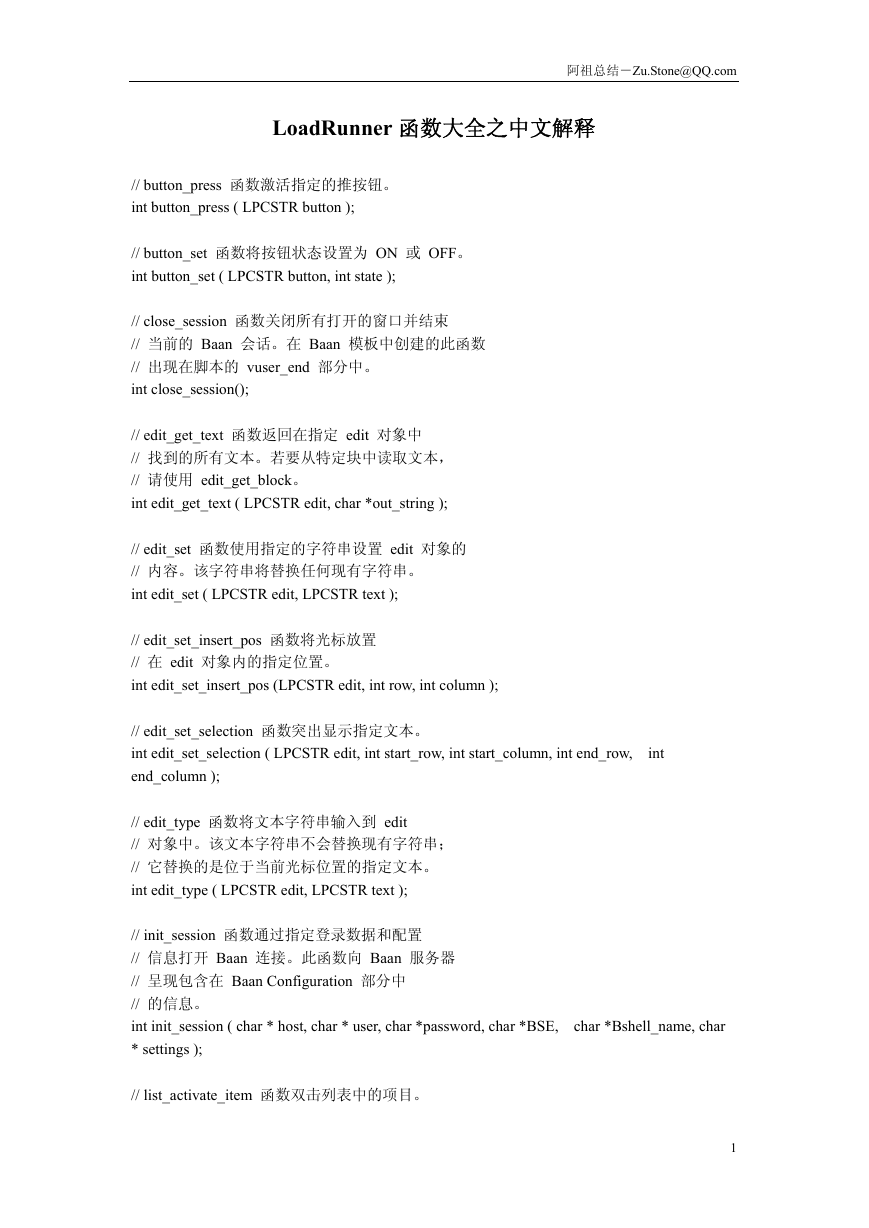
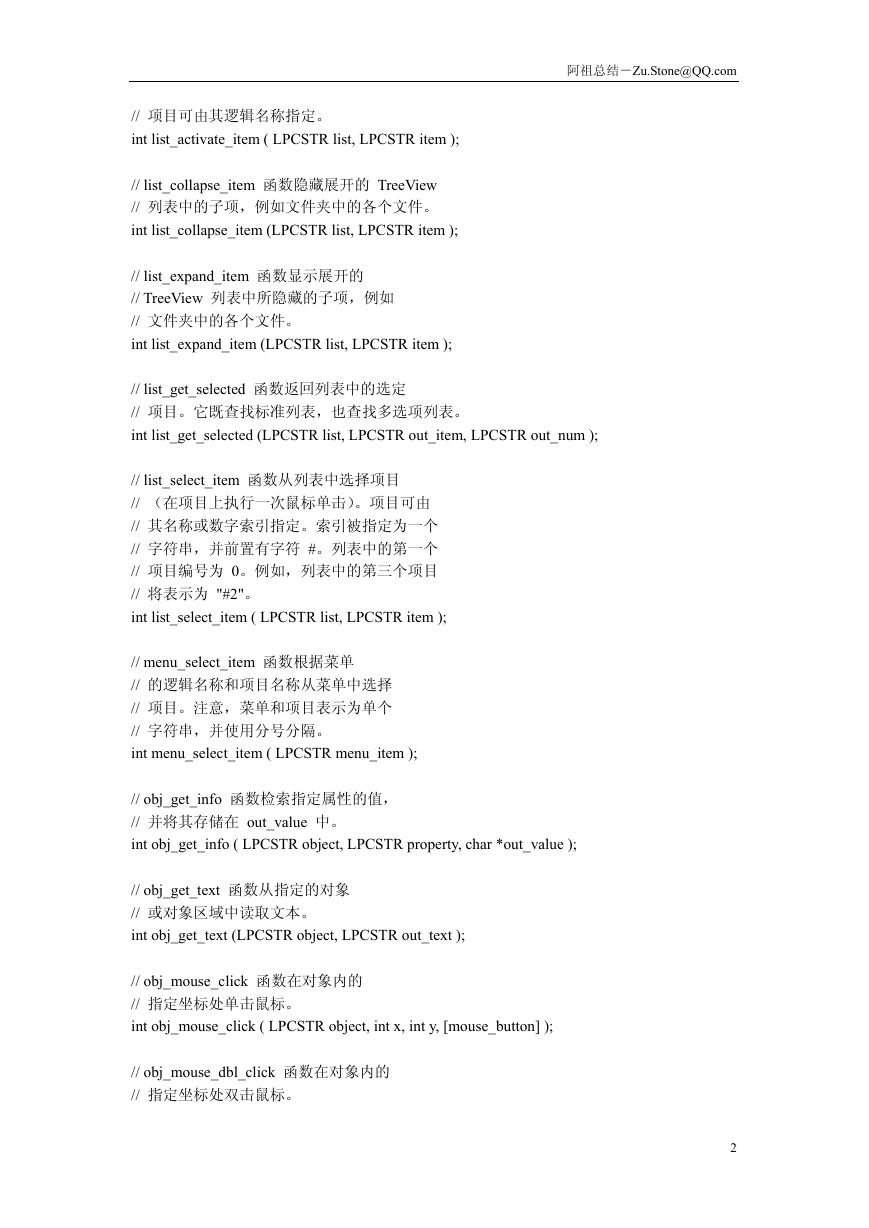

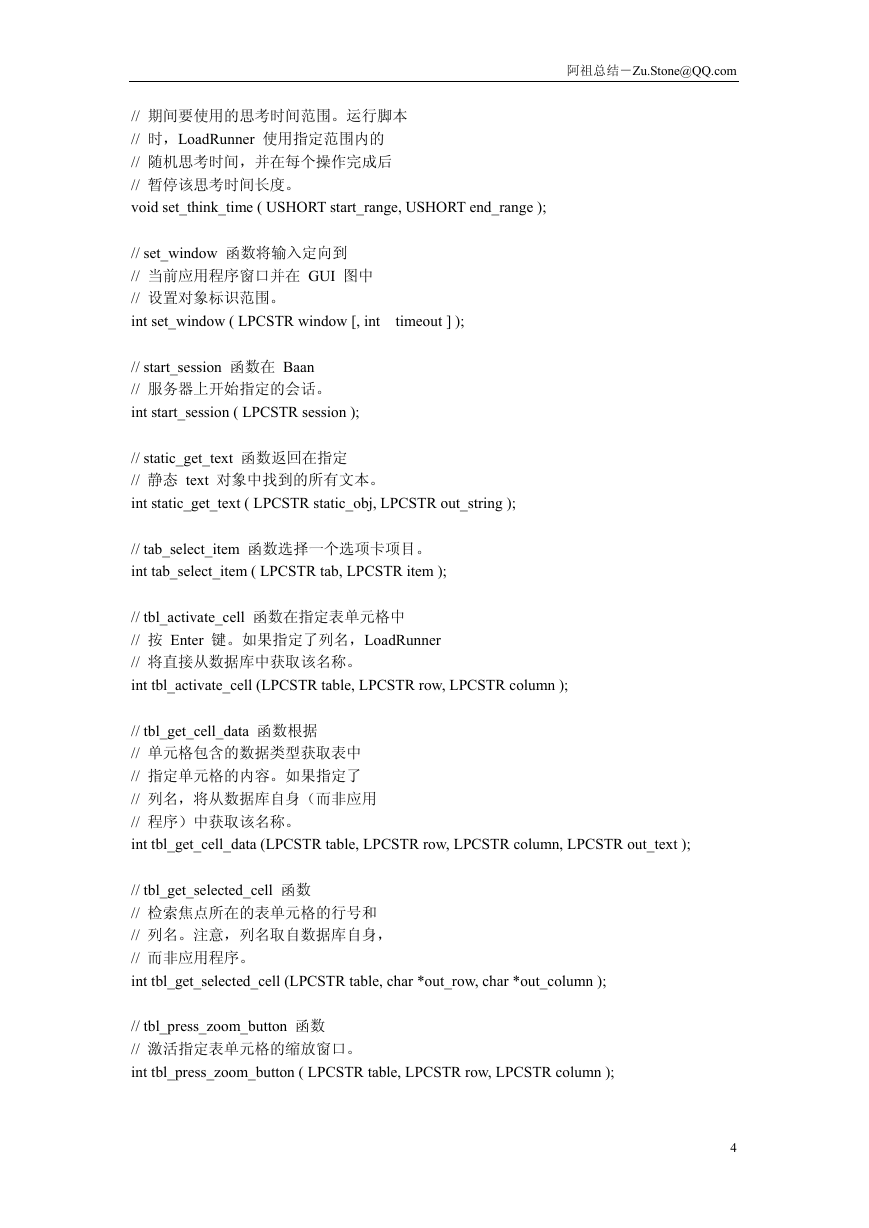
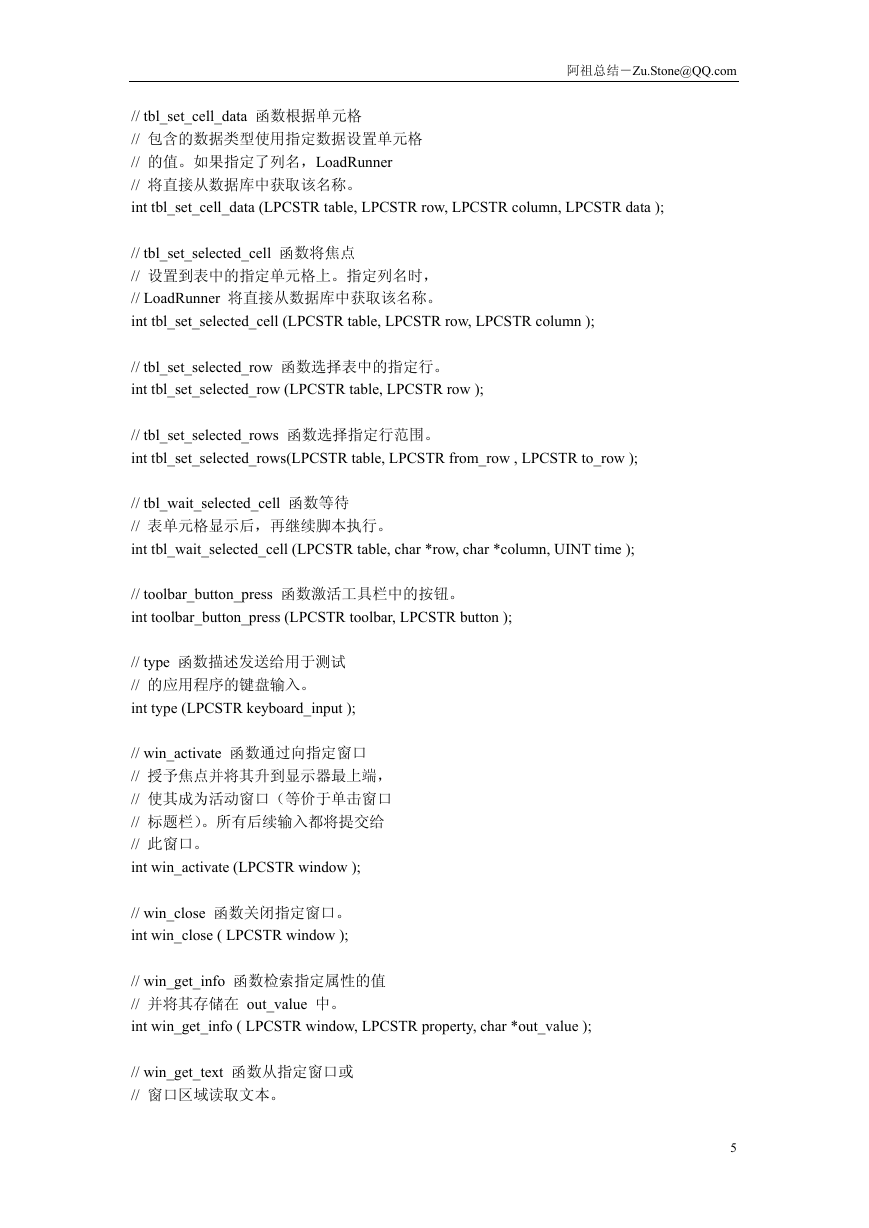
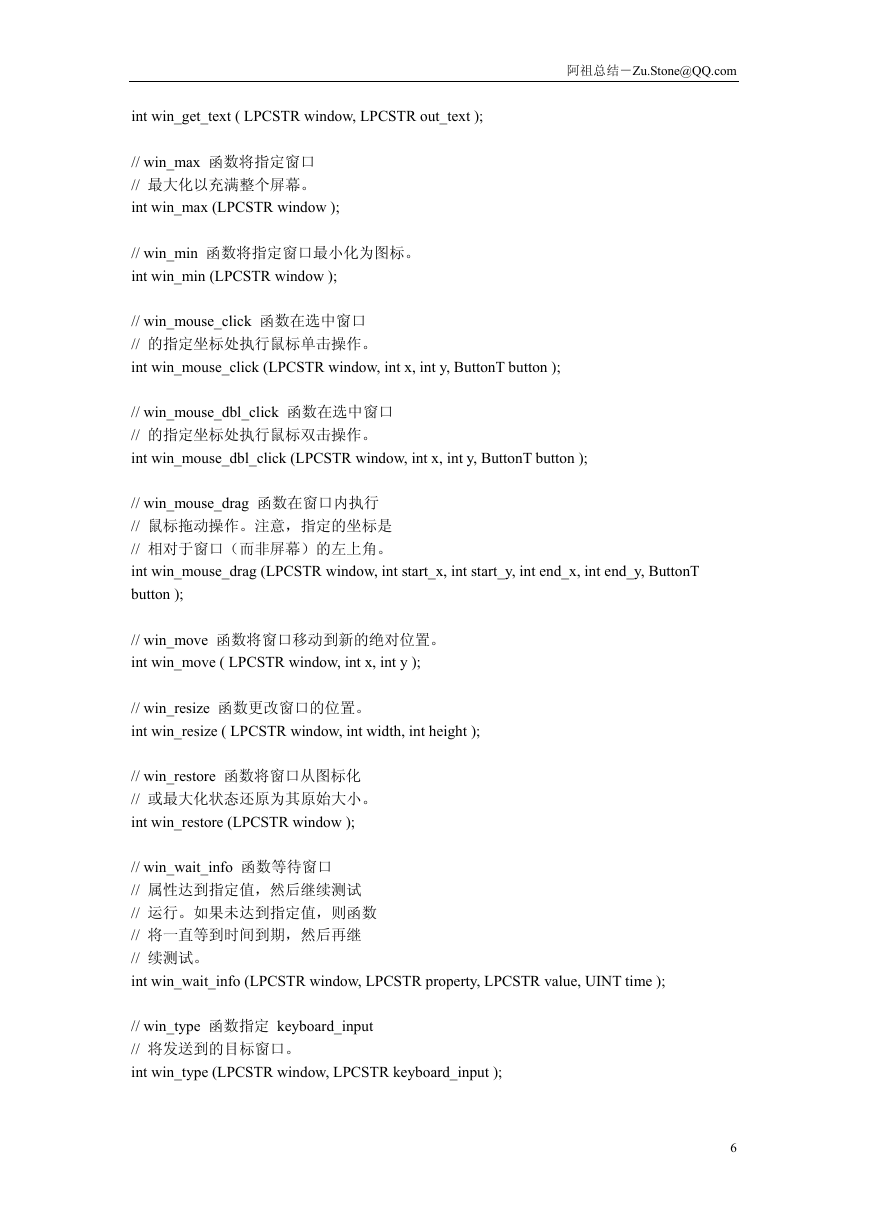
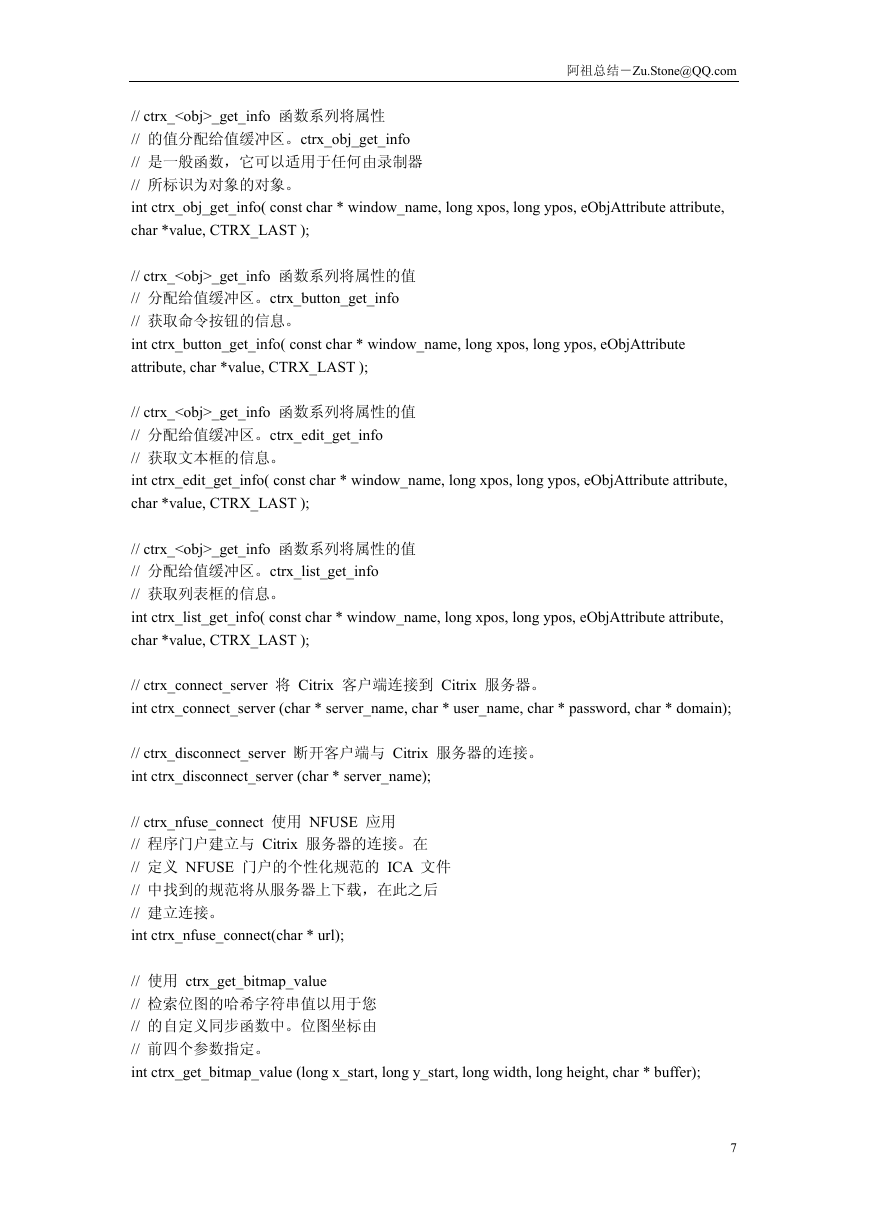
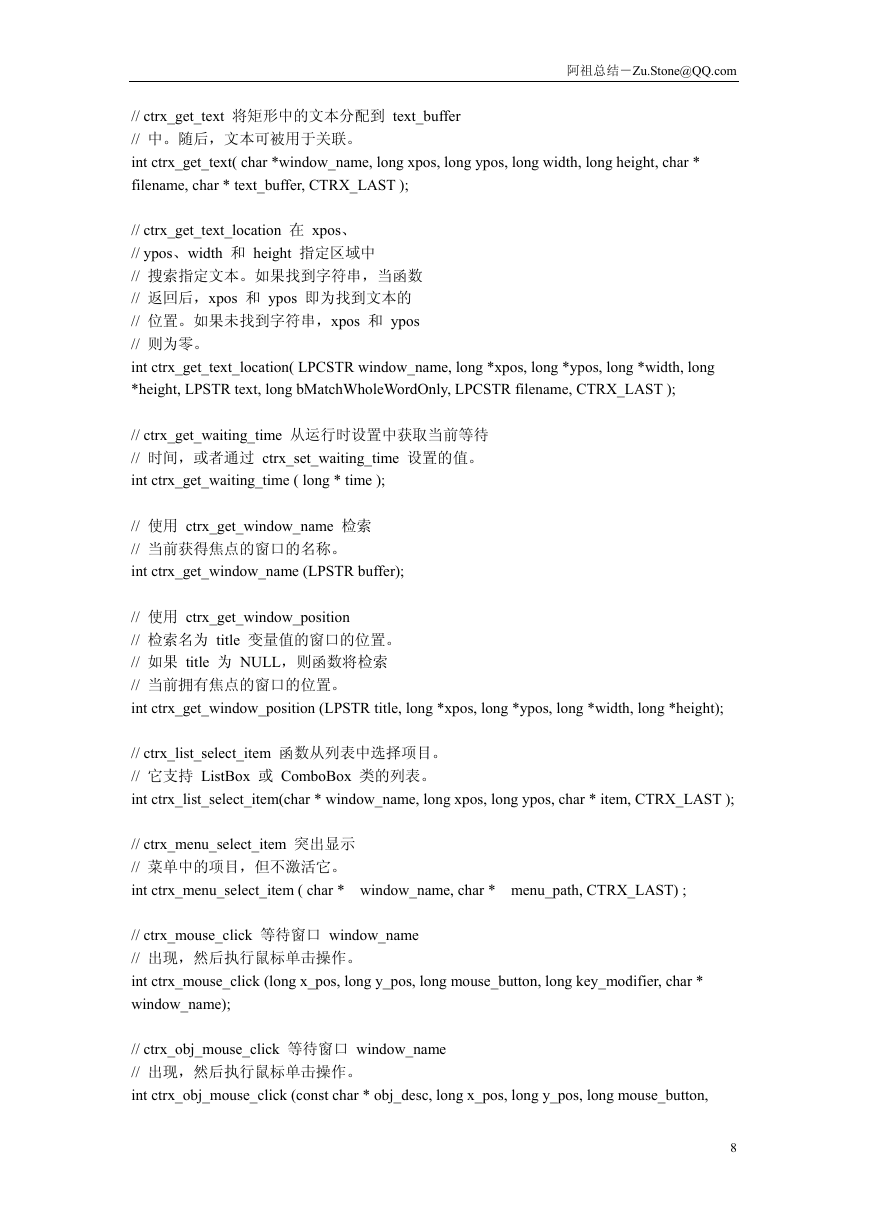








 2023年江西萍乡中考道德与法治真题及答案.doc
2023年江西萍乡中考道德与法治真题及答案.doc 2012年重庆南川中考生物真题及答案.doc
2012年重庆南川中考生物真题及答案.doc 2013年江西师范大学地理学综合及文艺理论基础考研真题.doc
2013年江西师范大学地理学综合及文艺理论基础考研真题.doc 2020年四川甘孜小升初语文真题及答案I卷.doc
2020年四川甘孜小升初语文真题及答案I卷.doc 2020年注册岩土工程师专业基础考试真题及答案.doc
2020年注册岩土工程师专业基础考试真题及答案.doc 2023-2024学年福建省厦门市九年级上学期数学月考试题及答案.doc
2023-2024学年福建省厦门市九年级上学期数学月考试题及答案.doc 2021-2022学年辽宁省沈阳市大东区九年级上学期语文期末试题及答案.doc
2021-2022学年辽宁省沈阳市大东区九年级上学期语文期末试题及答案.doc 2022-2023学年北京东城区初三第一学期物理期末试卷及答案.doc
2022-2023学年北京东城区初三第一学期物理期末试卷及答案.doc 2018上半年江西教师资格初中地理学科知识与教学能力真题及答案.doc
2018上半年江西教师资格初中地理学科知识与教学能力真题及答案.doc 2012年河北国家公务员申论考试真题及答案-省级.doc
2012年河北国家公务员申论考试真题及答案-省级.doc 2020-2021学年江苏省扬州市江都区邵樊片九年级上学期数学第一次质量检测试题及答案.doc
2020-2021学年江苏省扬州市江都区邵樊片九年级上学期数学第一次质量检测试题及答案.doc 2022下半年黑龙江教师资格证中学综合素质真题及答案.doc
2022下半年黑龙江教师资格证中学综合素质真题及答案.doc